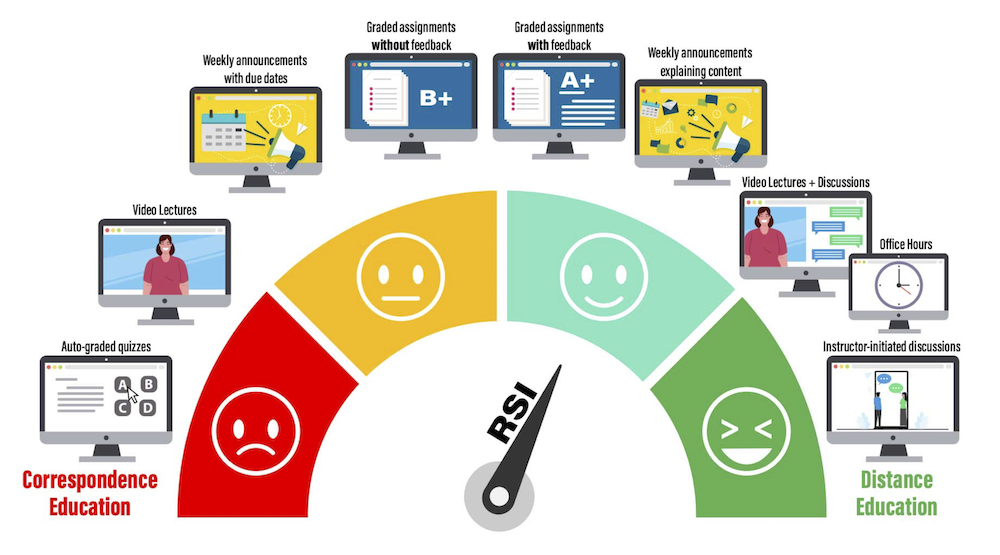Regular & Substantive Interaction
New federal US Department of Education (DoE) regulatory definitions of distance education require that institutions ensure regular and substantive interaction (RSI) between a student and an instructor(s).*

RSI compliance is the legal federal requirement that distinguishes the status of courses between distance education and correspondence courses. Correspondence courses are not eligible for financial aid. Institutions risk losing access to student financial aid if the institution is audited by the US Department of Education’s (DoE) Office of Inspector General, or as part of a periodic Departmental financial aid program review, and found to be out of compliance. Institutions may be required to repay financial aid associated with the correspondence courses and students. Regulations related to RSI have not been waived due to the COVID-19 pandemic.
Compliance with the US DoE regulations
New Regulations for Distance Education and Innovation (went into effect July 1, 2021)***
Regulations |
Past |
As of July 1st, 2021 |
|---|---|---|
| Interaction | Only initiated by the instructor | Mostly instructor initiated, some leeway |
| Instructor | Meets accreditation standards | Explicit reliance on accreditor approval |
| Substantive |
Of an academic nature | Has a list of activities (instruction, assessment, tutoring, answering questions) |
| Regular | Regular and somewhat substantive | Predictable and scheduled and tracking and intervention |
Definitions**
An instructor is an individual responsible for delivering course content and who meets the qualifications for instruction established by an institution’s accrediting agency. Eligible programs can be taught by “the instructor or instructors.
A distance education course is one in which instruction is delivered by one or more types of technology, including the internet, various wired and wireless media, or audio conference to students who are separated from the instructor(s). These technologies “support regular and substantive interaction between the students and the instructor or instructors, either synchronously or asynchronously.
Predictable and Scheduled Interaction: Regular interaction requires an institution to ensure, prior to the student’s completion of a course or competency, that there is the opportunity for substantive interactions with the student on a predictable and scheduled basis commensurate with the length of time and the amount of content in the course or competency.
The institution also is responsible for monitoring the student’s academic engagement and success and ensuring that an instructor is responsible for promptly and proactively engaging in substantive interaction with the student when needed on the basis of such monitoring, or upon request by the student.
Academic engagement requires active participation by a student in an instructional activity related to the student’s course of study as defined by the institution consistent with any requirements imposed by its state approval or accrediting agency. Academic engagement can include such activities as attending a class where the students and instructor can interact, turning in an academic assignment or taking a test, participating in an interactive computer-assisted instruction, participating in an institutional-directed group activity or online discussion, or interacting with the instructor regarding academic matters.
An emphasis on regular and substantive interaction is entirely consistent with well-documented research-based effective practices in online course design and delivery. In online teaching and learning environments of any kind, (asynchronous, synchronous, blended/hybrid), regular and substantive interactions must:
- Be with an instructor as defined by the institution’s accreditor.
- Be initiated by the instructor.
- Be scheduled and predictable.
- Be academic in nature and relevant to the course.
- Be a substantive interaction, which (assumes instructor-initiated academic interaction that is scheduled and predictable, and) engages learners in teaching, learning, and assessment, consistent with the content under discussion, and also includes at least two of the following:
- Providing direct instruction (i.e., live synchronous online interactions where instructor and learners are present online at the same time);
- Assessing or providing feedback on a student’s coursework;
- Providing information or responding to questions about the content of a course or competency;
- Facilitating a group discussion regarding the content of a course or competency; or,
- Other instructional activities approved by the institution’s or program’s accrediting agency.
Informational Webinar Recordings:
- OSCQR & RSI Webinar – SUNY Online Teaching webinar recorded September 22, 2021.
- Using OSCQR to ensure RSI – CPD OTTER webinar recorded August 11, 2021.
For more information:
Additional Sources:
• Regular and Substantive Interaction Refresh: Reviewing & Sharing Our Best Interpretation of Current Guidance and Requirements
• DoE Response Letter to questions about implementing RSI
• RSI Update
Citations & Attributions:
*Regular and Substantive Interaction documentation taken/adapted from the WCET Policy Playbook
**The RSI graphic illustration and some content has been adapted and is used with the permission of the SUNY Online Team.
***Retrieved from Regular and Substantive Interaction: Regulatory & Pedagogical Implications presentation by WCET